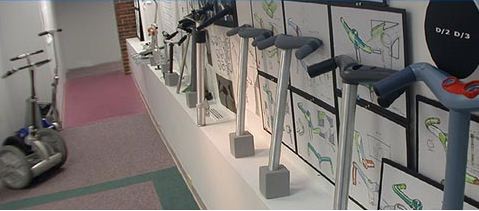

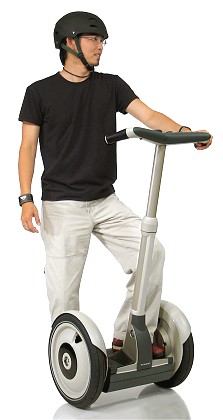

In addition to the smaller, lighter, more nimble nature of the new p133, it's price was intended to be more affordable. Earlier i and e Series models were priced at $5,000-$9,000, very high for the "average joe" because they were initially targeted for industry. The p133 was to be the model made for "the rest of us," regular people, and meant to be initially priced around $3000 (and eventually lower). Unfortunately, at its release in October 2003, the p133 was priced too high, at $3999. Only during a 3-month period (from July 1st to September 30th in 2004) during the "Glide Into Summer" promotion did Segway LLC offer a $1000 rebate on the purchase of a p Series and thus finally hit the pricepoint for which the p Series was originally intended, $2999. After that sale ended, it returned to $4K. With the smaller p Series priced high enough to only be $500 less than the i Series, salesmen could succeed in encouraging the customer interested in buying a p133 to "upgrade" to the i Series because "for only a few dollars more you get a bigger, stronger HT with a longer lasting battery, etc." In 2005, the release of longer-lasting lithium batteries (only available for i Series models) likely further limited interest in the p133. Hence it's not too surprising that it is estimated only 10% of the Segway HT sales have been of the elegant p Series.
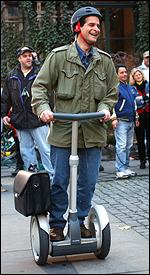
-Top speed: 10 miles per hour (16 km/h).
-Weight: 70 lbs (32 kg)
-Temperature: When stored and charged at room temperature, the p Series can operate in environments ranging from 40 to 122F (5 to 50C). Actual performance is dependent
on battery temperature, terrain, riding style and payload.
-Width: The Segway's footprint (how much space it covers on the ground) is 16 by 21.8 inches (41 by 55 cm). The platform is 6.7 inches (17 cm) off the ground. The p133's smaller size
allows you to more easily partner with other forms of transportation, such as the bus, your car, or even a packed subway.
-Weight capacity: Total capacity (rider & cargo): 210 lbs (95.3 kg); Rider: 100-200 lbs (45-91 kg). The Segway HT p133 is optimized for portability and can carry a rider up to 200 lbs.
It can also be fitted with an optional front bag that stores up to 10 lbs. of small gear.
-Range: About 6-10 miles (9-16 km) with a single charge.
-Driver interface: The Segway has a small multicolor LCD screen that tells the driver how much battery power is left and how well the vehicle is
functioning. The screen displays a cartoon face, which expresses the general condition of the vehicle. The driver interface is designed to be simple and intuitive.
-Motors: Each of the Segway's wheels is driven by a 2-horsepower electric motor that produce no emissions.
-Transmission: The two-stage transmission, built by Segway and Axicon Technologies, has a compact 24:1 gear ratio. It uses a helical gear assembly that significantly reduces
noise. The Segway team configured the two meshes
in the gear box (the points where gears connect) to make sound exactly two octaves apart. This means the sounds are in harmony, so the gear box make a more musical noise.
The gears are also designed to have noninteger gear ratios, meaning the gear teeth mesh at different points from revolution to revolution. This minimizes wear and tear to
extend the life of the gear box.
-Computer: The Segway's brain is made up of two circuit boards, housed in the vehicle's chassis. The circuit boards, which boast a
total of 10 microprocessors, normally work together, but each can function independently in the event of a computer problem. If one breaks, the other circuit board will
slow the vehicle down gradually to avoid an accident.
-Power: The Segway is powered by two rechargeable nickel metal hydride (NIMH) batteries. The p133 has been outfitted with two 48 cell NiMH battery packs. The batteries are designed
with on-board electronics that automatically monitor both the condition and temperature of the batteries. Batteries can be recharged by utilizing any 90 to 260 volt and 50 to 60 Hz AC outlet
(typically accessible in most countries). A complete cycle charge will take four to six hours, which at 10 cents per KW-h, equates to less than 10 cents of electricity. NiMH batteries are
designed for approximately 300-500 full charge/discharge cycles.
-Sensors: The Segway uses five gyroscopes and a collection of other tilt sensors to keep itself upright. Only three gyroscopes are needed -- the extra sensors are included as a safety
precaution. The Segway has an additional weight sensor built into its platform to tell the computer when a rider has stepped on.
-Brakes: The Segway doesn't have a braking system. To stop, the rider stands upright without leaning forward or backward, and the vehicle maintains its position.
-Turning radius: Since it only has two wheels, the Segway can rotate around a single axis (the wheels turn in opposite directions). This gives the Segway a turning radius of zero.
-Wheels: The Segway wheel consists of a forged steel wheel hub with a glass-reinforced thermoplastic rim. Each wheel is secured to the drive shaft with a single nut. The tires are made of a
silica compound, which provides good traction even on wet surfaces.
-Security: The Segway uses an electronic key system. The key, which looks something like a car lighter, stores a 128-bit encrypted digital code. The vehicle won't start unless the key is plugged into its port. The key can also store settings for vehicle operation.
Segways include one key for "beginner mode," where the vehicle has a lower maximum speed, and one key for "experienced mode." Segway plans to offer programmable keys down
the road, which well let users store particular operation settings.
-Chassis: The Segway's sensitive electronic equipment is housed in a sturdy die-cast aluminum chassis. According to Segway, the chassis can withstand 7 tons of force.
-Control shaft: The aluminum shaft that holds up the Segway's handlebars can be adjusted to different heights. Riders can attach clips to the shaft to carry bags or other cargo.
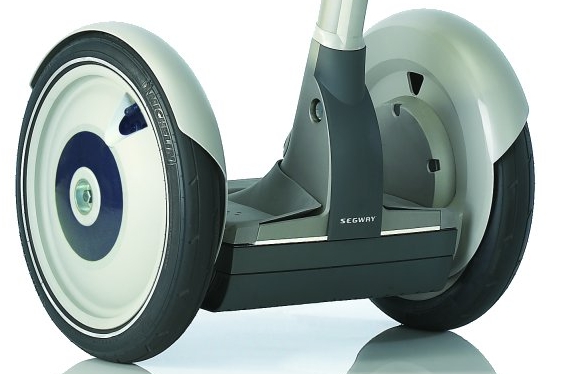
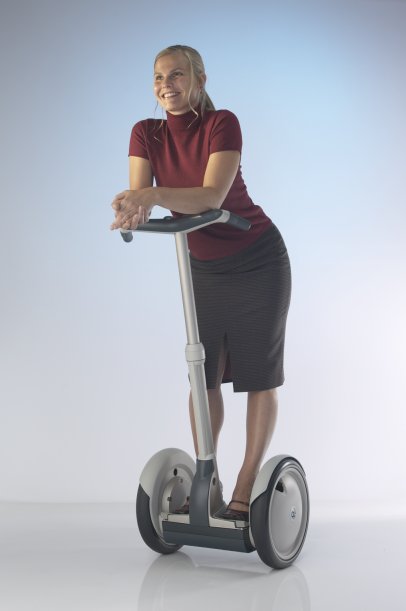

CHANGES: Elements of the original p133 Segway HT that differed from the earlier "i" or "e" Series design included: Smaller narrow tires (less tread) for flat surfaces, white solid wheels with one triangular punch-out, smaller titanium-colored fenders, lighter weight, smaller footprint, lower ground clearance, lower top speed, fewer (48 vs 60) NiMH battery cells in each of the two ligher (thus lower-range) battery packs, and small simpler mat. Also the appearance of the new "blue" colored mode button was initially noticed on p133s sold in early 2004. Both i Series and p Series models received an upgraded control shaft (better? connectors for the internal wires) in January of 2004 and that was indicated by the change from the old red to the new blue button.
